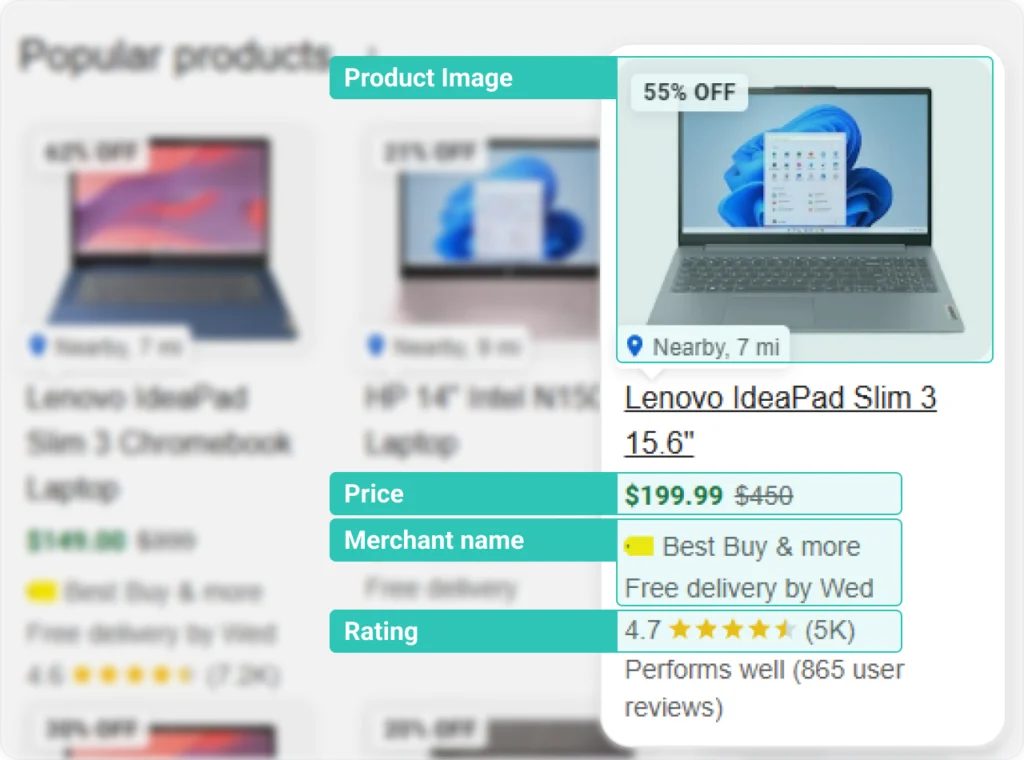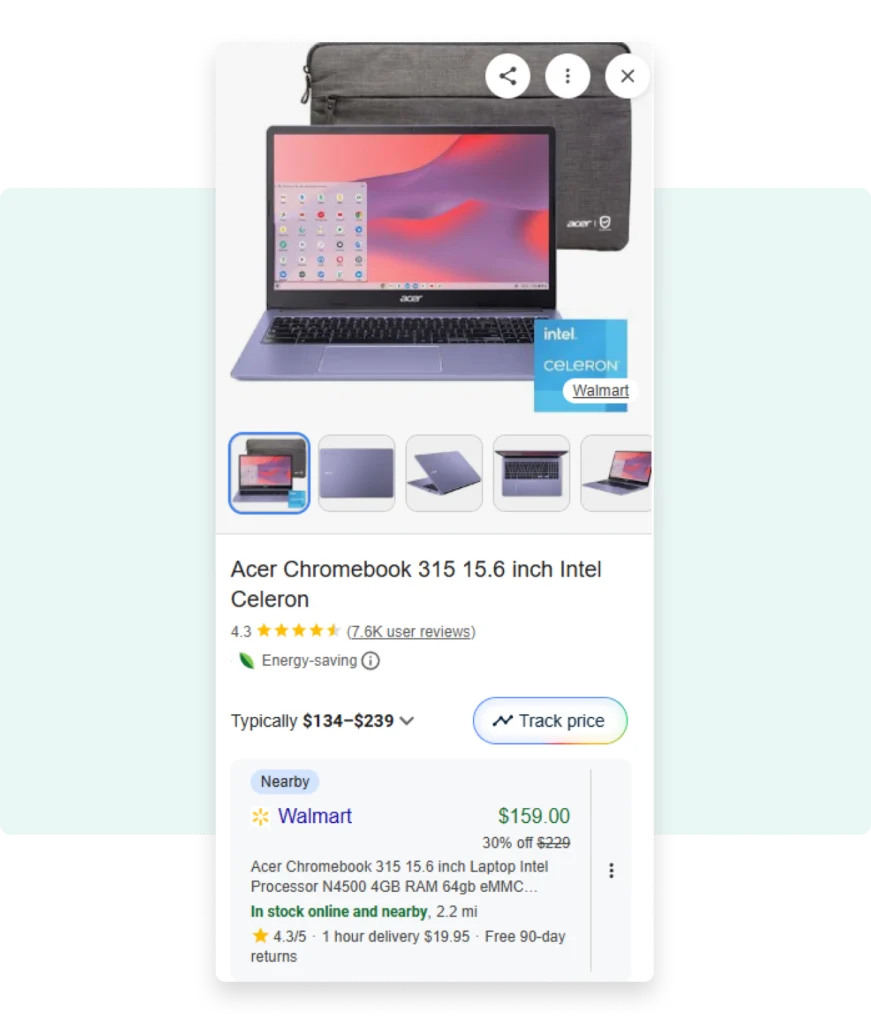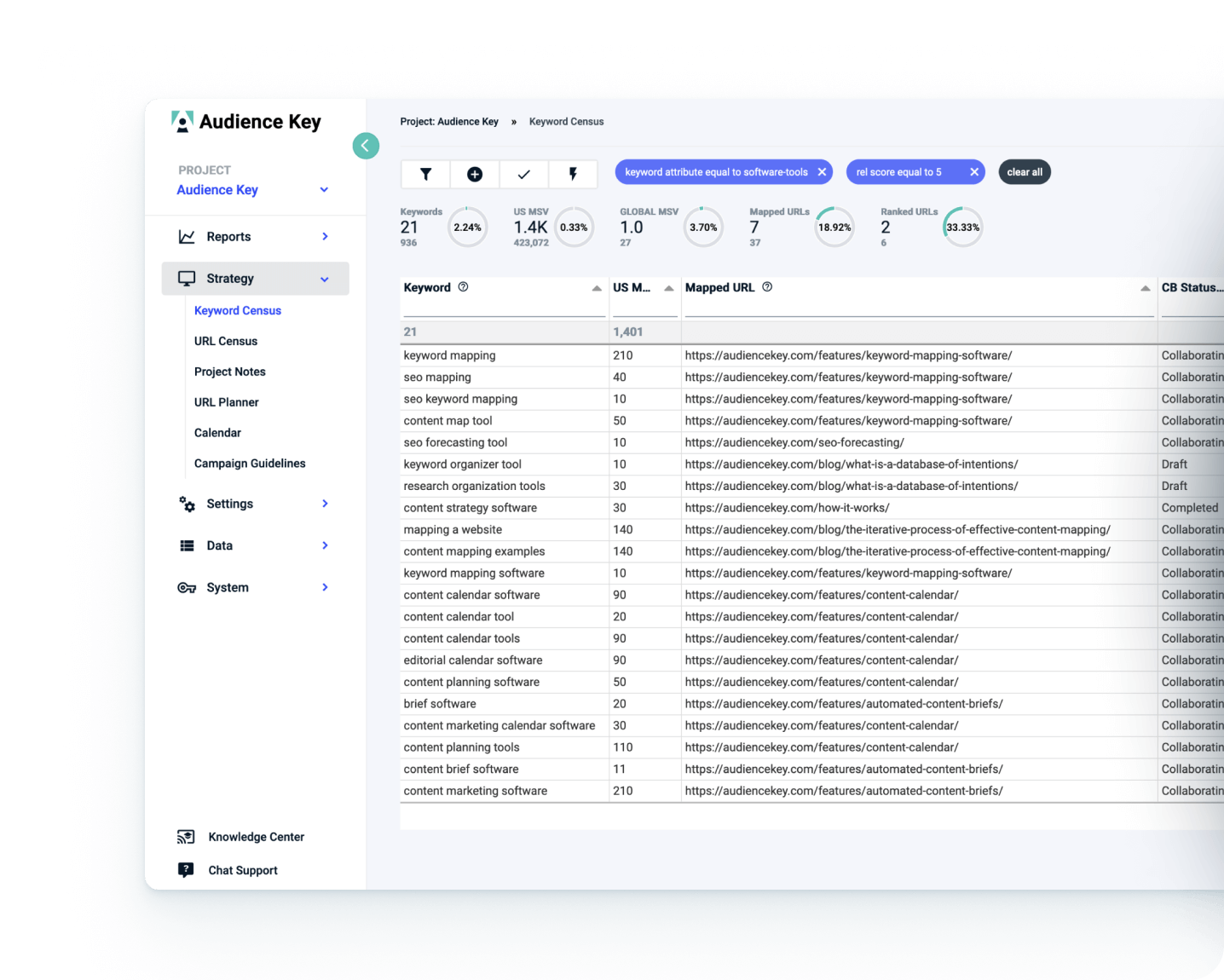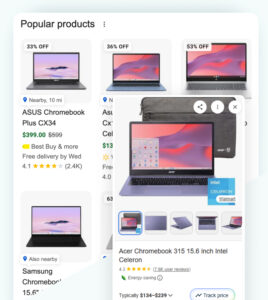If you sell products online and your Google Merchant Center feed is not optimized, you are leaving money on the table for Black Friday, Cyber Monday, and the rest of the holiday rush.
Feed fixes and enhancements can influence Google’s product grids and free listings in a matter of hours to a couple of days, not weeks. With Black Friday just days away, there is still time to get a meaningful lift before the peak shopping period wraps up.
Below, I’ll cover why the feed matters so much for organic product grids, what “fully filled out” actually means, how fast changes can take effect, and how you can track your impact with tools like Audience Key.
Product Grids Are The New Organic Shelf Space
When shoppers search for “black Friday TV deals” or “mens winter boots sale,” a page of ten blue links is NOT what shows up.
Instead, they encounter the free listings surfaced within the product grids.

Visual blocks labeled things like “Popular products,” “More products,” or “Best products” that appear in standard search results
- Cards that show product image, price, rating, and merchant name, pulled from your feed and your site
- Often, multiple grids on a single SERP, above or between traditional organic results
Google’s “free listings” and organic shopping features are powered by your Merchant Center product data and can surface across Search, Shopping, Images, and even YouTube.
Industry analyses over the last two years have been clear:
- Free listings and organic product grids have become a staple feature for ecommerce queries globally and now account for a large share of organic shopping visibility.
- Experts consistently describe these grids as the true “organic shelf space” for ecommerce SEO, because they dominate what users actually click on for high-intent product searches.
If your Merchant Center feed isn’t clean and complete, you’re either not in the game… or you’re playing it seriously handicapped.
Merchant Center Is Not Just A Paid Channel Anymore
Most teams continue to treat Merchant Center as PPC infrastructure, but that perspective no longer holds. Merchant Center now drives both paid and organic visibility, making it a shared space that requires coordination between SEO and paid media teams.
- Merchant Center and on-page structured data are the two highest-leverage technical inputs for organic product grid eligibility and performance.
- If your feed is broken, incomplete, or inaccurate, your products will struggle to show in organic product grids and free listings, even if your traditional SEO is strong.
Google’s own docs reinforce this. The official product data specification stresses that your Merchant Center feed powers both ads and free listings, and that missing or inaccurate attributes can prevent items from serving.
So for Q4, “fix your feed” is not just a PPC housekeeping task. It is a core SEO move.
How Fast Can Feed Changes Help Before Black Friday?
One of the most common objections in November is timing.
“Isn’t it too late to bother with the Merchant Center now?”
Not really. Hint: creating or optimizing a supplemental feed is an easy, quick win that can be done without IT support by using a simple Google Sheet. More on the supplemental feed in a minute…
Based on Google’s documentation and multiple third-party tests:
- When you edit product info, Google can process those updates in the Merchant Center in as little as about 15 minutes, assuming there are no policy issues.
- Personally, we have seen impact happen literally in under a minute!
- For established feeds, updates or added products often show as processed in the account within around 30 minutes.
- Once processed, products typically appear in Google Shopping and related surfaces within 48 to 72 hours if the feed is in good shape, with some listings appearing in roughly a day.
There is always some variance based on account history, policy flags, and the size of your catalog. But the key takeaway is simple:
You do not need a month. If you start now, you can still see movement in product grids and free listings during Black Friday and Cyber Week.
What “Fully Filled Out” Feed Quality Really Means
Having “a feed” that technically passes validation is not enough. To earn visibility in organic product grids, you want your product data to be both complete and competitive.

Google’s product data spec calls out required and recommended attributes that directly affect eligibility and ranking.
Focus on these areas before the holiday rush hits.
1. Core data points and basic hygiene
At a minimum, make sure these are accurate and present wherever applicable:
- id
- title
- description
- link (canonical URL)
- image_link (high-quality)
- price and sale_price (if relevant)
- availability
- condition
- brand
- GTIN and MPN where available
Missing or incorrect identifiers are one of the fastest ways to get disapproval or “not eligible” flags, which takes products completely out of the grid.
2. Augment your feed data
The above list is the core, but there are lots of additional fields that will provide richer, more robust and more detailed information about your products. Each shopping category has its own criteria – here are some standard ones to include if they make sense.
- Shipping costs, weight, and timing
- Material(s)
- Dimensions
- Color(s)
- Gender
- Is bundle or multipack
- Product highlights
- Google product category
- Age_group
- warranty
The list goes on – but you get the point.
All else being equal, if two merchants are selling the same product and only one is supplying Google with the full set of relevant, enriched attributes, which one is Google more likely to promote? The answer is obvious: the merchant with the more complete feed wins.
3. Titles that match how people actually search
Google allows up to 150 characters for titles in the feed, but many SERP layouts will truncate titles at 70 characters or less, which means you need to front-load your most important info.
Best practices from feed optimization studies include:
- Include brand, product name, and product type in a natural sequence
- Avoid stuffing in every variant or marketing tagline
- Treat Black Friday and Cyber Monday promos carefully. Use promotions and sale_price attributes rather than jamming “Black Friday deal” into every title
During Q4, descriptive and search-aligned titles help your items stand out in crowded grids.
4. Rich, truthful descriptions
Product descriptions in the feed help Google understand relevance and can support both paid and free placements.
A few ways to improve your descriptions immediately:
- Include primary and secondary keyword phrases naturally
- Highlight key specs and differentiators that matter to holiday buyers, such as materials, fit, or compatibility
- Reflect real inventory and variant details. Do not oversell or misstate features, because policy violations can stall your whole account when you need it the most
- Descriptions for product feeds can be up to 5,000 characters! Yet often merchants are using their default SEO meta description, which is generally under ~160 characters. Opportunity wasted!
5. Product categorization and product_type
Google_product_category and product_type are often neglected, but they play a significant role in how Google groups and compares items.
Before the holiday rush, take time to:
- Ensure all top sellers are assigned to precise categories in Google’s taxonomy
- Use product_type to reflect your internal structure (for example, “Home > Bedding > Duvet Covers”) so reporting and bid strategies stay aligned
- Fix generic or placeholder categories that were auto-generated by your ecommerce platform
6. High-quality images that win the click
Product grids are visual first. Users often pick what to click based on the image and price before they even look at the domain.
Google’s guidelines prioritize:
- Clear, high-resolution images on a clean background
- Showing the actual product variant that matches the color or style selected
- Avoiding overlaid text or promotional badges that violate policies
- Submit a series of images to qualify for 3-D images
If you only have time for a partial image refresh before the holidays, focus on:
- Your top revenue SKUs
- Products featured in Black Friday and Cyber Monday promos
- Product categories that already get strong search demand
7. Shipping, returns, and price accuracy
Holiday shoppers are extremely sensitive to shipping costs, delivery windows, and return policies. Google also uses shipping and tax settings in the Merchant Center as part of eligibility and quality scoring.
Short-term priorities:
- Make sure shipping tables and delivery estimates are current and accurate for holiday cutoffs
- Reflect sale pricing and promotional discounts in price and sale_price, not just on page banners
- Keep your inventory feeds updated frequently so you do not show out-of-stock items in grids
Use Supplemental Feeds For Fast, Targeted Fixes
If your primary feed is coming from a platform like Shopify or BigCommerce, or a complex custom feed that is hard to change quickly, supplemental feeds are your secret weapon.
Supplemental feeds can be published in a simple Google sheet – thereby allowing marketers the flexibility to test and experiment without dependency on the IT department.

A supplemental feed in Merchant Center lets you:
- Add missing attributes and enrich product data without touching the main feed
- Correct outdated titles or descriptions in bulk
- Apply custom labels and other attributes for campaign segmentation
Important details:
- Supplemental feeds cannot create new products. They only modify products that already exist in a primary feed, matched on id or other keys.
- You can use them to layer in Q4-specific data, such as promo labels, improved titles for best sellers, or temporary category refinements
You can launch a supplemental feed now, push a more competitive set of titles and attributes for your top SKUs, and see that flow into grids relatively quickly, without risking a big break in your core integration.
Promotions And Deals That Surface Directly In Grids
For Black Friday and Cyber Monday, it is not just about showing up. It is about standing out.

Merchant Center has built-in support for promotions and coupon codes that can appear directly on your product tiles, including for free listings in some cases.
Holiday plays that are worth considering:
- Percentage off or dollar off promotions for specific collections
- Free shipping promos highlighted at the product card level
- Time-bound offers that line up with Black Friday weekend or specific holiday windows

If users can see at a glance that your card is “20 percent off” or “Black Friday deal,” you will often win the click even if you are not the cheapest option.
Why Measurement Matters: Audience Key And Product Grid Tracking
Most rank tracking has historically focused on blue links. That is becoming less useful for ecommerce in a product grid world.
Audience Key is the first platform built to track merchant listings inside organic product grids at scale. It maps keyword demand to grid appearances, Product Cards per Merchant, and movement over time.
Real-world example:
- When Amazon made changes to its Google Shopping strategy earlier in 2025, Audience Key’s data showed that Amazon’s organic product card rankings dropped by more than 30 percent across roughly 79,000 keywords, and later disappeared, freeing up visible space for other merchants.
That type of measurement is exactly what you want during Q4:
- Before and after snapshots of your product grid visibility when you clean up your feed
- Competitive share of shelf vs your top rivals in core categories
- Identification of which categories respond best when you upgrade titles, enrich attributes, or introduce promotions
If you already use Audience Key, this is the time to lean on its ecommerce grid ranking reports. They turn your Merchant Center optimization work into something you can quantify and socialize with stakeholders.
A Practical Q4 Merchant Center Checklist
If you need a concrete plan for the week ahead, here’s the sequence I’d follow if I were optimizing a feed today.
- Confirm eligibility and account health
- Check for policy issues, disapprovals, or account warnings in Merchant Center
- Fix any critical violations that could block free listings
- Prioritize your top revenue and promo products
- Identify your top 10 to 50 SKUs for Black Friday and Cyber Monday
- Ensure they all exist in the feed and are eligible for free listings
- Enrich titles and descriptions for those products
- Align titles with how users actually search during the holidays
- Update descriptions to highlight key benefits and differentiators
- Tighten categories, product_type, and branding
- Fix generic categories and missing product_type fields
- Make sure brand fields are populated and accurate
- Use a supplemental feed for rapid improvements
- Launch a supplemental feed targeting those high-priority SKUs
- Layer in better titles, product_type, custom labels, or promotional flags
- Set up promotions for your key offers
- Configure Merchant Center promotions with accurate start and end dates
- Validate that promo badges are appearing correctly on test queries
- Monitor performance with Audience Key and Merchant Center reports
- Use Audience Key to track product grid visibility and share of grid over time.
- Use Merchant Center’s free listings and surface reports to see clicks, impressions, and product-level troubleshooting.
Final Thought
In a world where product grids and free listings dominate high-intent ecommerce searches, your Merchant Center feed is not a back office detail. It is the data engine that powers your organic shelf space.
The upside is that it is one of the few levers you can still pull right before Black Friday and see real movement. If you invest a focused block of time into cleaning up and enriching your feed, then pair it with solid product grid reporting from a platform like Audience Key, you are not scrambling. You are buying visibility when it matters most.





